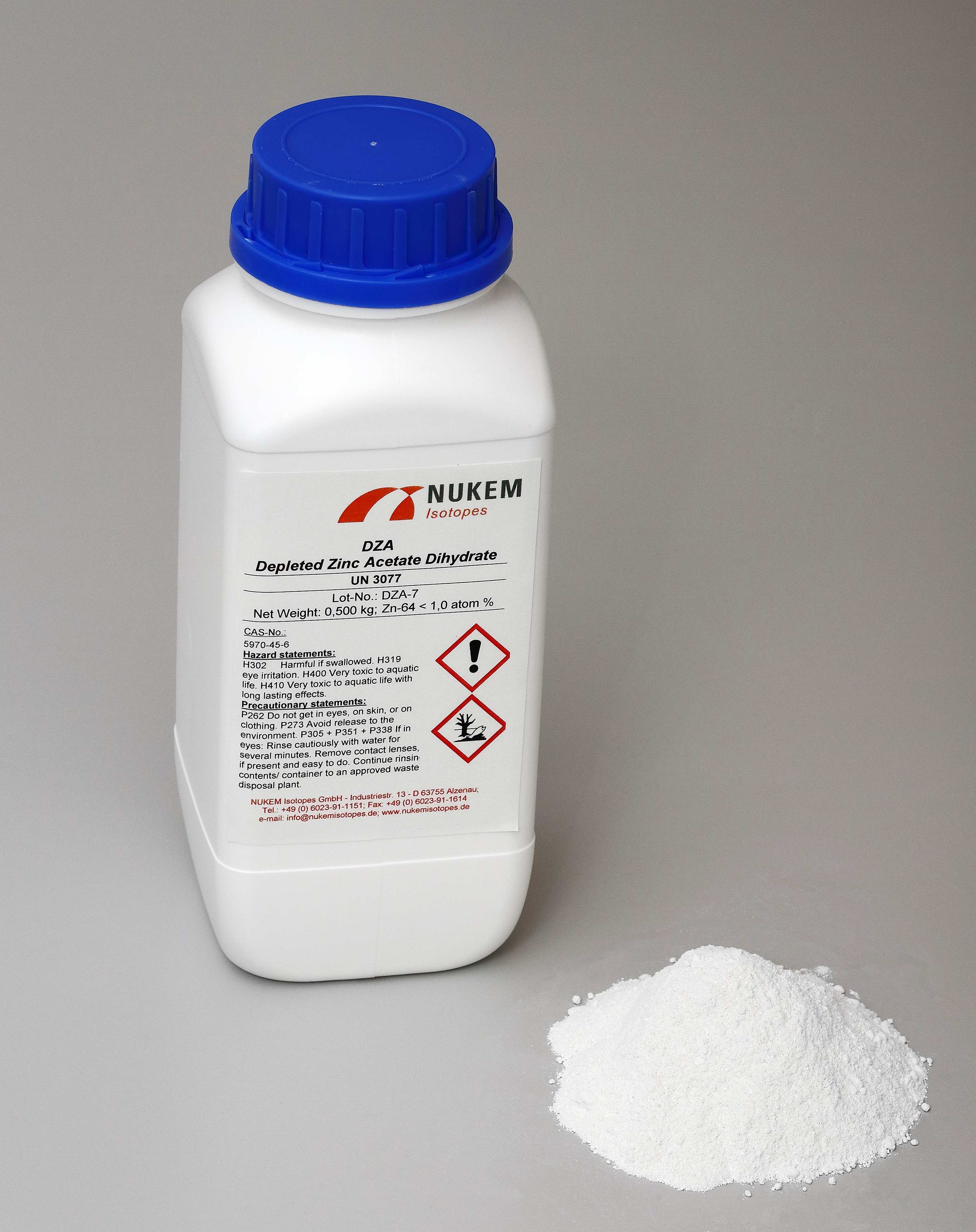
Depleted Zinc for the Nuclear Industry
- Zinc, depleted in the isotope 64Zn, is a product for the water chemistry of nuclear power plants (NPPs).
- Depleted Zinc in the form of sintered Zinc Oxide Pellets is used in boiling water reactors (BWR).
- Depleted Zinc in the form of Zinc Acetate is used in pressurized water reactors (PWR).
- The aim of using Depleted Zinc is to reduce corrosion in the primary water circuit in order to reduce occupational radiation exposure for NPP personnel (possible reduction of collective dose rate is approx. 50 %).
- Another goal is the reduction of the potential for stress corrosion cracking in PWRs.
- American BWRs (mainly GE types) started with the use of Zinc Oxide in form of natural zinc. The residual dose uptake problem from the activation of 64Zn to 65Zn has been successfully avoided in the United States, Mexico and some European countries by using Depleted Zinc.
Specification
Depleted Zinc-64 in the form of Zinc Oxide Pellets
Physical Properties:
| Material | 64Zn Depleted Zinc Oxide in the form of sintered pellets |
| Zn-64 | 64Zn ≤ 1,0 at% |
| Density | > 4,77 g/cm³ |
| Diameter | 10 mm + 1mm |
| Length | 10 mm + 1mm |
Chemical Properties:
| Form | ZnO |
| Purity | > 99,8 wt% |
Impurities in μg/g
| Ag | ≤ 10 |
| Al | ≤ 50 |
| As, Au | ≤ 10 |
| B, Ba, Be, Bi, Br | ≤ 10 |
| C | ≤ 500 |
| Ca, Cd, Ce, Cl, Co, Cr, Cs, Cu | ≤ 10 |
| Dy | ≤ 10 |
| Er, Eu | ≤ 10 |
| F, Fe | ≤ 10 |
| Ga, Gd, Ge | ≤ 10 |
| Hf | ≤ 10 |
| Hg | ≤ 2 |
| Ho | ≤ 10 |
| I, In, Ir | ≤ 10 |
| K | ≤ 10 |
| La, Li, Lu | ≤ 10 |
| Mg, Mn, Mo | ≤ 10 |
| N, Na, Nb, Nd, Ni | ≤ 10 |
| Os | ≤ 10 |
| P, Pb, Pd, PO4, Pr, Pt | ≤ 10 |
| Rb, Re, Rh, Ru | ≤ 10 |
| S, Sb, Sc, Se | ≤ 10 |
| Si | ≤ 50 |
| Sm, Sn, SO4, Sr | ≤ 10 |
| Ta, Tb, Te, Th, Ti, Tl, Tm | ≤ 10 |
| U | ≤ 10 |
| V | ≤ 10 |
| W | ≤ 10 |
| Y, Yb | ≤ 10 |
| Zr | ≤ 10 |
| Rare Earth | ≤ 20 |
| Insoluble | ≤ 100 |
| Remaining impurities | ≤ 20 |
Depleted Zinc-64 in the form of Zinc Acetate Dihydrate
Physical Properties:
| Material | 64Zn Depleted Zinc in form of Zinc Acetate |
| Zn-64 | 64Zn ≤ 1,0 at% |
| Particle Size | not specified (crystals) |
Chemical Properties:
| Form | Zn(CH3CO2)2(H2O)2 |
| Purity | ≥ 99,8 wt% |
Impurities in μg/g
| Ag | ≤ 10 |
| Al | ≤ 50 |
| As | ≤ 10 |
| Au | ≤ 20 |
| B, Ba | ≤ 10 |
| Be | ≤ 20 |
| Bi, Br | ≤ 10 |
| Ca, Cd | ≤ 10 |
| Ce, Cl | ≤ 20 |
| Co, Cr | ≤ 10 |
| Cs | ≤ 20 |
| Cu | ≤ 10 |
| Dy | ≤ 20 |
| Er, Eu | ≤ 20 |
| F | ≤ 20 |
| Fe | ≤ 10 |
| Ga, Gd, Ge | ≤ 20 |
| Hf | ≤ 10 |
| Hg, Ho | ≤ 20 |
| I, In | ≤ 10 |
| Ir | ≤ 20 |
| K | ≤ 10 |
| La | ≤ 20 |
| Li | ≤ 10 |
| Lu | ≤ 20 |
| Mg, Mn, Mo | ≤ 10 |
| N | ≤ 20 |
| Na | ≤ 10 |
| Nb, Nd | ≤ 20 |
| Ni | ≤ 10 |
| Os | ≤ 20 |
| P, Pb | ≤ 10 |
| Pd, PO4, Pr, Pt | ≤ 20 |
| Rb, Re, Rh, Ru | ≤ 20 |
| S, Sb | ≤ 10 |
| Sc | ≤ 20 |
| Se | ≤ 10 |
| Si | ≤ 50 |
| Sm | ≤ 20 |
| Sn | ≤ 10 |
| SO4 | ≤ 50 |
| Sr | ≤ 10 |
| Ta, Tb, Te, Th | ≤ 20 |
| Ti | ≤ 10 |
| Tl, Tm | ≤ 20 |
| U | ≤ 20 |
| V | ≤ 10 |
| W | ≤ 20 |
| Y, Yb | ≤ 20 |
| Zr | ≤ 20 |
| Rare Earth | ≤ 20 |
| Insoluble | ≤ 100 |
| Remaining impurities | ≤ 10 |

